
Fins open to transcendence
An interview with London-based French artist Marguerite Humeau
When the curator and concept of the 2nd edition of the Riga International Biennial of Contemporary Art (RIBOCA2) were announced, it was soon widely suspected that the London-based French artist Marguerite Humeau (1986) would be among the ranks of artists due to her long and fruitful cooperation – and friendship – with the biennial’s curator-in-chief Rebecca Lamarche-Vadel. Of course, this did eventually turn out to be the case. As I finish writing this interview in April 2020, it is now known that RIBOCA2 has been postponed due to the COVID-19 pandemic, yet before the closing of the borders I managed to visit one of its potentially most interesting artists at her London studio.
For her modest age of 34, Humeau has accomplished rather much. She has had solo exhibitions at Nottingham Contemporary and the Palais de Tokyo (FOXP2, 2016), Tate Britain (Echoes, 2017), Manifesta 2016, Frieze London (Visions, 2016), and Nottingham Contemporary and the New Museum in New York (Birth Canal, 2018). She has been nominated for the Prix Marcel Duchamp and has received the Battaglia Foundry Sculpture Prize, the Zurich Art Prize, the Royal British Society of Sculptors Bursary Award and others. Her work can be found in the collections of MoMA in New York, Tate London, the Centre Pompidou in Paris and the Fonds de Dotation Famille Moulin in Paris, among others. After she participated in a show curated by Hans-Ulrich Obrist at the Serpentine Galleries in 2014 (for which she resurrected Cleopatra’s voice singing an ancient love song), the curator wrote: “Humeau may be a young artist, but her work reaches back to before the dawn of human history itself.”
So it is, indeed, for much of Humeau’s work – mostly manifested in the form of sculpture or installation – deals with deep time and the extinction of forgotten beings. In her reflections, she mixes science, history, myth, conspiracy theories, animalism, bioethics and many other aspects and viewpoints. As she has said of her own work: “Research gives credibility to my stories. I use scientific facts but also, and more importantly, speculations and fictions. I want to create strong physical, almost supernatural experiences.” One of the latest topics she has focused on is whether, after witnessing the mass extinction of their peers and other species due to environmental collapse and climate change, wild animals of our age might begin developing some sense of spirituality. After visiting Humeau’s studio and our conversation, this idea certainly seems more credible to me than before.
Do you remember how you became interested in extinct animals?
In 2010, I participated in a project that focused on imagining scenarios about things that would happen when biotechnologies become much more intertwined in our daily lives. That was just after Michael Jackson died, and I wondered what would happen if we could recreate the larynx, the vocal cords of dead people. I discovered a company that was printing organs from cells with the help of 3D printers. And so I was thinking about the future of this – maybe we could recreate the larynges of singers and other icons? But if we could do that, we could also do it on an industrial scale. Basically, meaning that we would be able to have the larynx of someone performing at different places at the same time. Then I began thinking about how that would be the equivalent of the digital revolution – one could be present in many different places at the same time, but instead of being present through a screen, the person’s larynx would be physically present. So I started looking into extraordinary voices that unfortunately don’t exist anymore. Furthermore, I started thinking about extinct animals, and what would happen if we were able to recreate their voices and therefore also, in a way, their physical presence.
Marguerite Humeau. Echoes, installation view. 2015 / Image Credit: Marguerite Humeau/DUVE Berlin / The yellow design background that serves as a platform for Humeau's sculptures was created by Direct Painting Group
Marguerite Humeau. Echoes, installation view. Taweret Year: 2015. Polystyrene, white paint, artificial prosthetics, plastic container, water pumps, water, rapamycin, resvetarol / 90 x 180 x 230 cm / Image Credit: Marguerite / Humeau/DUVE Berlin / The yellow design background that serves as a platform for Humeau's sculptures was created by Direct Painting Group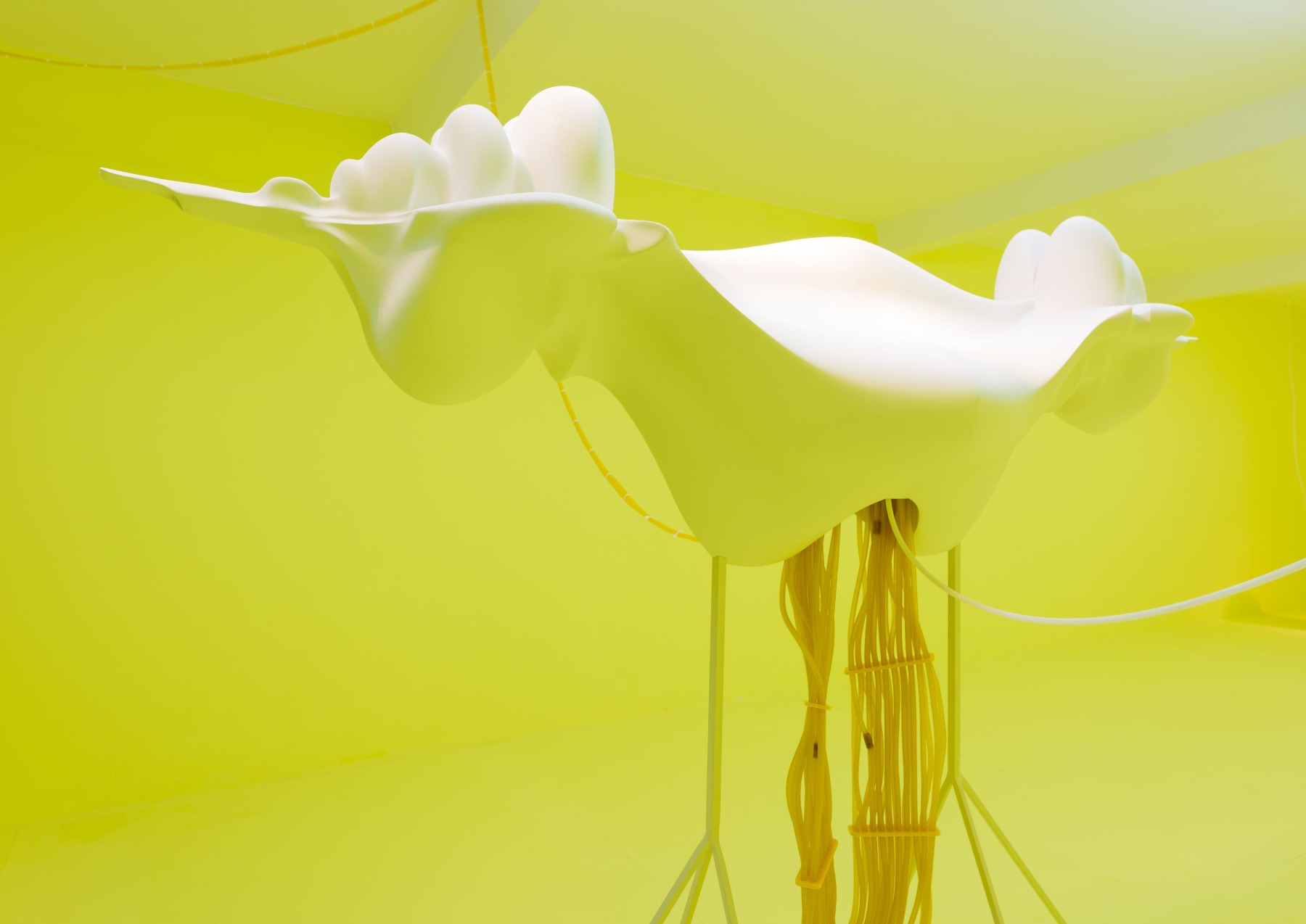
There’s this wonderful book by Jeffrey Sconce, Haunted Media, in which he talks about the connection between communication technologies and the supernatural. For example, when the telegraph was first invented, the Fox sisters invented “celestial telegraphy” to try to talk to a ghost that was haunting their home. There are a lot of times when a new technology emerges that people try to use it in such ways. For instance, you can imagine what it might have felt like to talk to someone on the phone for the first time – it must be really weird to feel such a presence in real time. So, this all started to come together in my head, the relationship between the voice and the presence. I also started to take an interest in prehistoric creatures, which became my graduation work. And since then, I feel like I’ve just been expanding on these topics.
I started thinking about extinct animals, and what would happen if we were able to recreate their voices and therefore also, in a way, their physical presence.
What would it mean to us to be able to hear the voices of prehistoric animals?
I guess it would be a very special feeling of being able to experience times that were deep in the past or far in the future. Bringing together all these times and spaces that are really distant from us makes us feel very small in comparison to... We’re just a blast of wind. It’s a way of decentring the human to make us feel that we belong to a much larger history of the Universe, in which we are just one very small dot.
Marguerite Humeau. Echoes, installation view. Wadjet (King Cobra). 2015. Polystyrene, white paint, artificial prosthetics, artificial human saliva, 1g King Cobra venom sourced in Florida / 90 x 210 x 230 cm (including stand) / Image Credit: Marguerite Humeau/DUVE Berlin / The yellow design background that serves as a platform for Humeau's sculptures was created by Direct Painting Group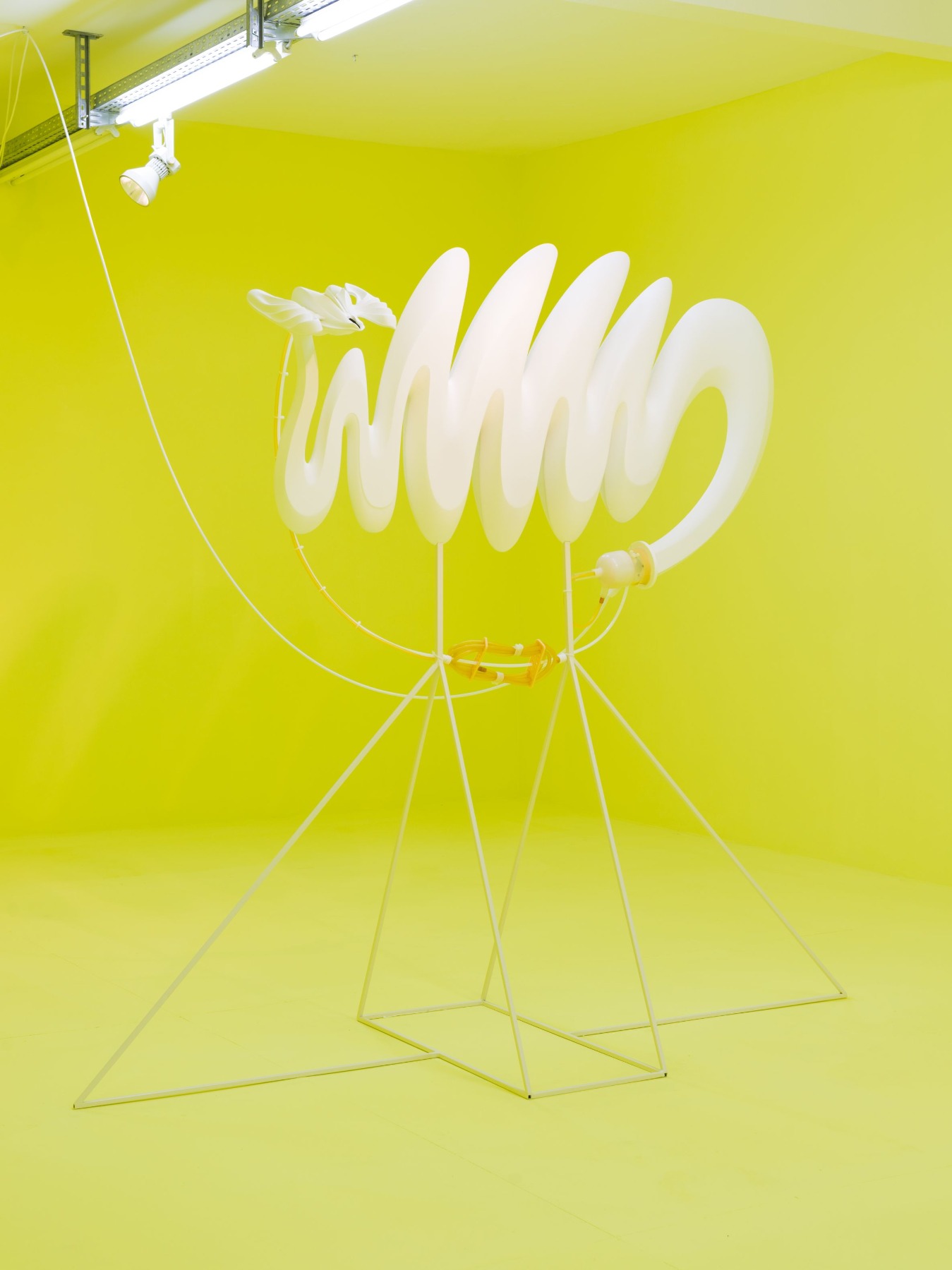
Haven’t you ever thought that you are too overfocused on dead things instead of living ones?
[Laughs.] Yes, of course I have. I think about it all the time. One key to all my works is that they’re all about life and death. That sounds very basic, of course, but my main interest is how the new technologies are redefining the way we think about life and death, and creating new ways of living, new ways of existing, new ways of being present, in-between states.
Besides the extinct, I’m also interested in the forms that are yet to come. If you look at my projects, there are almost never dead things in my installations; they’re always either somehow alive or in those in-between states. Either they’re between life and death, or in stages of mutations, or with bodies here but souls elsewhere, etc. It’s true that I mainly work in sculpture and inert objects, but I feel more like I create beings and different states of existence that can take the form of sculptures as well as voices, or poisons, or other substances. All the substances I use are always somehow active; they have some kind of life or are producing energy in some way. That’s how I see it.
Marguerite Humeau. Sphinx Otto Protecting Earth from Humankind (from the Riddles series), installation view, Bosquet de l’Arc de Triomphe, Château de Versailles. 2017. Artificial Human Skin (gel coat, tinted resin, marble powder, fiberglass), skeleton (steel), toxic labyrinth composed of the most toxic plants on Earth, selected from black magic recipes (including Cornus Sanguinea, Cornus alba Siberica, Salix Alba Chermesina, Hamamelis, Sedum) / Sculpture: 6000 (W0 x 3250 (H) x 2850 (L) mm, Plant labyrinth: variable / Courtesy the Artist and C L E A R I N G New York / Brussels / Image Credit: Julia Andreone
I have this diagram on which the vertical axis reaches from deep in Earth’s crust up to the heavens, and the horizontal axis is time – from deep in the past to far in the future. Assuming that time is linear, of course, which I don’t agree with, but for this diagram it helps. So, all of my projects originate at one point on this axis and are about bringing things back to the present or seeing how present things could look in the future or how they could have looked in the past. Or, like hijacking the axis of time and thinking: what if this wouldn’t have happened? What if we were thinking about parallel evolution lines? It’s all about probabilities, hypotheses and speculation.
Marguerite Humeau. Sphinx Otto Protecting Earth from Humankind (from the Riddles series), installation view, Bosquet de l’Arc de Triomphe, Château de Versailles. 2017. Artificial Human Skin (gel coat, tinted resin, marble powder, fiberglass), skeleton (steel), toxic labyrinth composed of the most toxic plants on Earth, selected from black magic recipes (including Cornus Sanguinea, Cornus alba Siberica, Salix Alba Chermesina, Hamamelis, Sedum) / Sculpture: 6000 (W0 x 3250 (H) x 2850 (L) mm, Plant labyrinth: variable / Courtesy the Artist and C L E A R I N G New York / Brussels / Image Credit: Julia Andreone
Let’s focus for a moment on the dimension of technology and the probabilities that future life might hold. Are you often afraid of what might lie in these probabilities and the world they would bring about?
Yes, for sure. But I always try to keep my own opinion out of it. At the beginning, many people were saying that I basically just wanted some new age of clones to take place, but I just make experiments that ask what would happen if this or that were to happen. I don’t want to give too much of my own opinion in my work. I want to ask questions fairly. Also, I don’t really think the point in my work is political. Sure, it’s hard not to be political when talking about clones, but my main intention is not for people to ask themselves whether it would be good to clone mammoths. It’s more open than that. It’s about experiencing those worlds, encountering those presences, feeling for them or being empathetic with them. It’s about physically experiencing almost-supernatural ecosystems. Maybe it’s about attempting to trigger an experience of the sublime, or something close to it, by projecting ourselves into ancient times and spaces that each of us humans might hold in our own memories.
My main interest is how the new technologies are redefining the way we think about life and death, and creating new ways of living, new ways of existing, new ways of being present, in-between states.
Although much has already been written about it, could you, in your own words, briefly describe the process and plausibility of – and, indeed, the reasons for – reconstructing Cleopatra’s voice? What’s the foundation behind this work of yours?
After I did my first work on prehistoric creatures, I thought a lot about all the voices I would like to hear. And Cleopatra came to mind. At first, I have to admit, it was just pure personal fascination. She’s such an icon, and everyone has an image in their heads of what she looked like, which is weird, because nobody really knows what she looked like. She has somehow become much more than she actually was in her own time. What also struck me is the fact that her body has never been found. It’s purportedly known that she was buried with her lover, but they’ve never been found. And I thought it was interesting that there’s such a gap between the image we have of her and the fact that we’ve never even found her body, so we can make no analysis of her tissue nor speculate about what her face really looked like. She only lives through representations.
Then I found out that Cleopatra spoke nine languages, all of which are extinct today. I found a love song from her time, an ancient Egyptian song translated into English, and then I tried to find people who could help me translate the song into the each of the nine languages that Cleopatra spoke. But I couldn’t find all of them. For some of the languages, like Latin and Ancient Greek, it’s pretty easy to find people who know them. But some of the other languages were only spoken by very, very specific communities. For instance, one of these extinct languages was closely related to one that is nowadays spoken only by people in Duhok, Kurdistan (in what is still theoretically part of Iraq), so I had to find ways to contact people there. And some of the extinct languages I just didn’t find at all. They had no written form and have simply completely disappeared. Looking for a spoken-only language is also a strange way to look at extinction – you’re looking for something that has been, but at the same time you’re being told that there’s no trace of it at all. Nothing.
Looking for a spoken-only language is also a strange way to look at extinction – you’re looking for something that has been, but at the same time you’re being told that there’s no trace of it at all.
And what about the particular sound of her voice, which, by the way, I found very enchanting. How did you arrive at that particular timbre if we know nothing about Cleopatra’s larynx?
I asked for help from some very advanced voice engineers in Paris, and at the same time I met another voice engineer from the University of Cambridge, and, of course, they knew each other, because voice engineering is a pretty small world. We started to discuss my project, and they asked me, “Well, what do you think she sounded like?” So, I found this text by Plutarch, in which he described Cleopatra’s voice. I also asked a few surgeons who specialise in the larynx to give me some clues as to what we might infer from everything we know about Cleopatra. So, all these surgeons and scientists tried to help me to extrapolate this. But most interesting for me was the description by Plutarch. He said that Cleopatra had a voice that sounded like an instrument of many strings. His description is realistic at the beginning, but then he goes on to sound pretty supernatural. I thought it would be amazing to recreate a voice that would sound like what’s described in that text.
There are various different techniques in voice engineering. One is that you just create a voice from scratch. At the time I was doing this project, it was still very hard to achieve something through this technique that sounded remotely natural. But I wanted a voice that could shift from one tone to another, reflecting Plutarch’s description. So, instead of creating the voice from scratch, we decided that I would find an existing voice that was close enough to the description, and then we would work on it with different kinds of synthetic voice software to create these mutations. They have really amazing tools to make such mutations! For instance, you can inject the voice of a human into the tonal cavity of a flute or violin, and then the result is kind of like having a violin speak. You can also change the age of the voice – they can make your voice sound as it will when you’re ninety-five. So, we worked with that. I wanted Cleopatra’s voice to sound, as you said, highly enchanting, but also highly scary at the same time. I wanted the listener to feel the void that stands between this sound and its source. It resonates in an empty shell – there’s nothing, nobody, no substance. It’s just the voice, and it’s somehow fascinating and terrifying at the same time. That’s what I wanted to create.
You have the nickname “Indiana Jones in Google times”. Did you come up with it yourself?
No, I think it was written somewhere, I think in 2014, in a press release by a curator friend of mine. Since then, everyone has taken it up. [Laughs.]
I’ve always been amazed by how life managed to arise from water, fire and rocks. This is the most exciting riddle for me. The history of existence.
Does it annoy you?
No, I think it’s actually quite spot-on. Of course, now that it’s been used so much – perhaps a little. But at the very beginning, when I saw it for the first time, I thought it was interesting, because, you know, I go on these kind of quests, on these adventures of sorts to find things that are sometimes big mysteries of human existence. I do it sometimes by excavating evidence, but mostly through conversations, research, reading. So I wouldn’t say I’m an explorer in the traditional sense, but sometimes I go on quite extraordinary travels. For instance, I once went to Thailand to get elephant tears for my Palais de Tokyo project.
Marguerite Humeau. Riddles (Jaws), installation view, Schinkel Pavillon, Berlin Year: 2017. Mirrored finish stainless steel, internal communication system, hypnotising scrolling led lights, hand-blown glass eyes, clicking metallic jaws, electronic systems / Dimensions: variable / Courtesy: the Artist and C L E A R I N G New York / Brussels / Image Credit: Julia Andreone
What historical riddles are you most interested in? For example, from what I understand, you relate the development of human consciousness to the development of the vocal cords. Are there other riddles in the history of culture, life or the universe that really captivate your imagination?
I think the first one is the primordial soup, you know? Thinking about what Earth looked like before life appeared, about this liquid that covered Earth and from which life emerged. It’s a process that took millions of years, and I’ve always been amazed by how life managed to arise from water, fire and rocks. This is the most exciting riddle for me. The history of existence.
Another might be, for instance, the origin of religion. I’m fascinated to understand how we began to think that there might be something else besides us. What happened in our minds, what was the trigger? Why was there suddenly a need to look at the Universe, the Cosmos, to try to understand what it all means? Now religion is everywhere, and beliefs in different systems of knowledge and understanding are abundant. But I’d like to understand the origin of the need for all that. I have to say, behind all the things we talk about, there’s usually just a really pure and naive fascination with the grand mysteries. At the beginning, there’s always naiveté.
While doing my research on the origin of religions, I found that chimpanzees have been observed to build temples, or what we think might be something like temples. A team of researchers discovered a pile of rocks that was made by chimpanzees, so they set up a camera there and found that the chimpanzees came back to the pile of rocks, as if on some sort of pilgrimage. And I began wondering... At the same time, I was doing research about Göbekli Tepe in Turkey, which is one of the oldest temples in the history of mankind; it dates back to the 10th–8th millennium BCE. And during this parallel research I began to wonder whether both people and chimps understood what was happening when religion was born, if they understood what they were doing or not.
But you are a fan of conspiracy theories, are you not?
Well, not a fan...
I feel that by secluding art in museums we’ve also been removing it from the heart of our lives.
Let’s say you enjoy them.
Yes, let’s say that. [Laughs.] I mean, I started looking into them. I did this project a very long time ago about some volcanoes in Antarctica that look like volcanoes on Europa, which is Jupiter’s moon, and at the time there was a lot of research done on them, because the conditions in that region of Antarctica, under the snow, were exactly the same as the conditions on Europa, and they had found life, small animals, living in these volcanoes without oxygen. It completely changed the way scientists looked for life, because realising that life can exist without oxygen opens up new possibilities. And that’s when I started looking at conspiracy theories, because, while researching these volcanoes, I found this conspiracy theory blog on which people are looking at Google Earth pictures to seek holes in the Earth that would connect to alien activity. One of the people on this blog had made a connection between Antarctica and Jupiter’s moon Europa without knowing about the actual scientific research, which also hinted at a similar conclusion.
But maybe I’m not so much interested in conspiracy theories as I am in the occult sciences. I’m interested in finding out what happens when you put all different forms of knowledge on the same level. Because I feel like scientific discourse excludes a lot of forms of knowledge; it has become the official discourse that has made other forms of knowledge forgotten. For instance, regarding our relationship with the natural world... I was inquiring about animal brains and their possible psychedelic effects and their relation to early occurrences of trance in prehistoric times. It might be that prehistoric man had much more and different knowledge about Earth and nature than we do, and this knowledge has been completely forgotten. Now we’re rediscovering this connection, but it’s not new – it was already here and then forgotten. So yes, this really fascinates me. All these sources of knowledge that I would like to bring back to the stage. I think this is a drive that brings all my work together – bringing back to the surface forms of knowledge or forms of being that have been excluded from the official discourse. Similarly as bringing back to life or giving a voice to beings that have not been part of the official history but have nevertheless existed.
Also, when I was working with the early states of trance, I went to the Lascaux caves. I bought and read a book that makes a connection between the shamanic ecosystem and especially the underworld, and that the prehistoric caves could perhaps be its real, physical translation in the human world. In other words, it’s thought that prehistoric caves were used by shamans in their ceremonies, and if they believed that spirits were living in the Earth’s crust, then the walls of the caves might have become like membranes between the human world and the spiritual world, membranes almost like elastic skins. During the ceremony, the spirits would come so close to the membranes that they would imprint their shapes on them, and that’s maybe what the shaman would see inside a cave and, in effect, paint on the walls. And perhaps that became what we now know as the prehistoric wall paintings. I really love this idea, because it’s an explanation of the Lascaux paintings that doesn’t connect them with the imagination or depiction, but is actually real experience.
Maybe I love this theory because it says that art had real spiritual function for early humans and the images came from things they were actually seeing, and they were making visible what was invisible for the rest of the group – because only the shaman could see them. So, they may have had this very important function in those communities. To be honest, this is what I, as an artist, am striving to do – to understand that art can have a similarly important function in our lives today as well. I feel that by secluding art in museums we’ve also been removing it from the heart of our lives. If this theory is true, art emerged from an urgent need to get together and to connect with these spirits. I’m excited to think about art created by people who’ve never thought about it as art, and how their creations assume a new function and interact with other audiences.
Marguerite Humeau. High Tide (The Dancer I, The Dancer II, The Dancers III & IV), exhibition view, Centre Pompidou, Paris. 2019. / Image Credit: Julia Andréone Courtesy the artist, C L E A R I N G New York/Brussel York/Brussels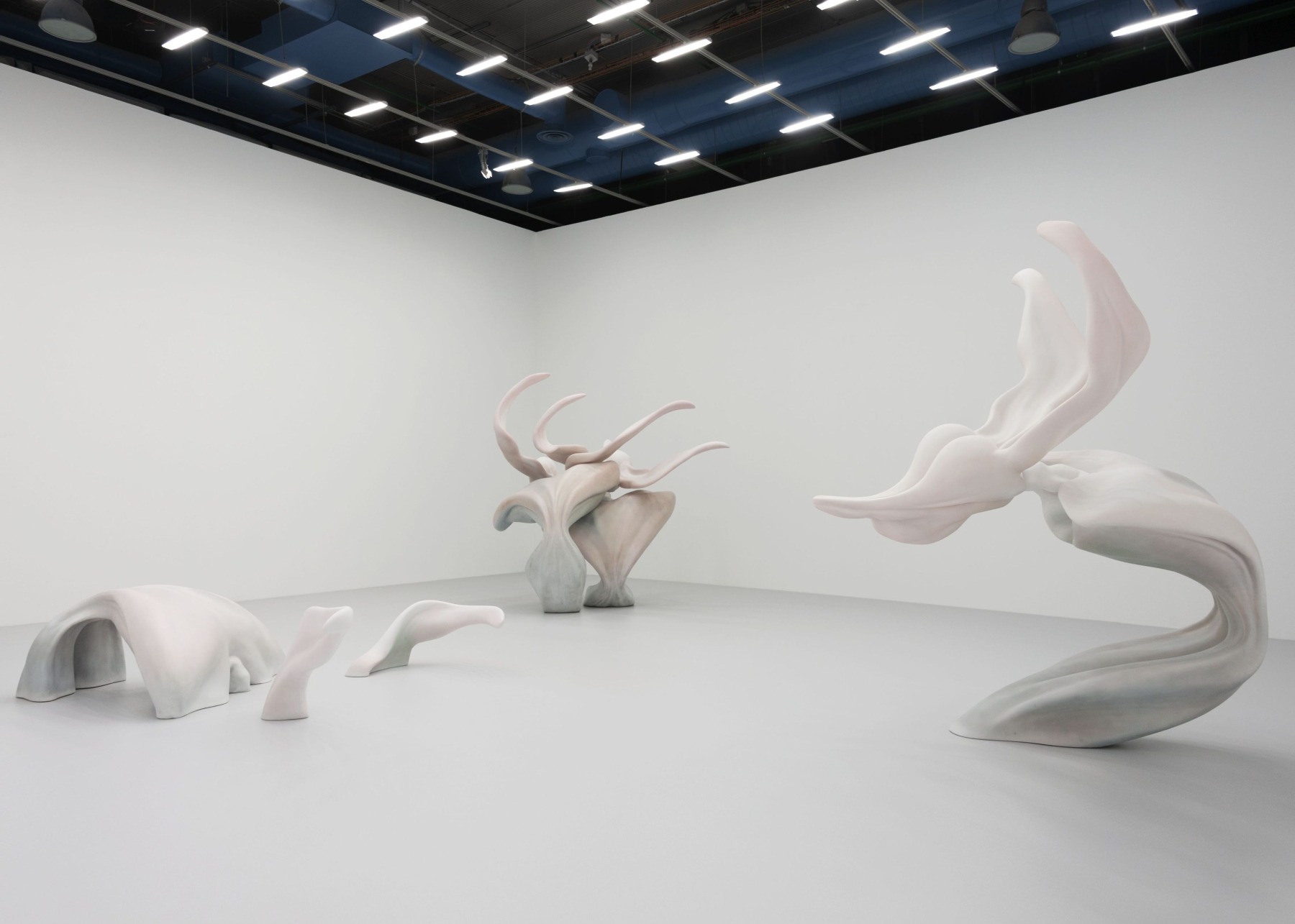
Marguerite Humeau. The Dancer I, A marine mammal invoking higher spirits, exhibition view, Centre Pompidou, Paris. 2019. Polystyrene, polyurethane resin, fibreglass, steel skeleton, pollution particles. 205 x 172 x 255 cm / Image Credit: Julia Andréone Courtesy the artist, C L E A R I N G New York/Brussels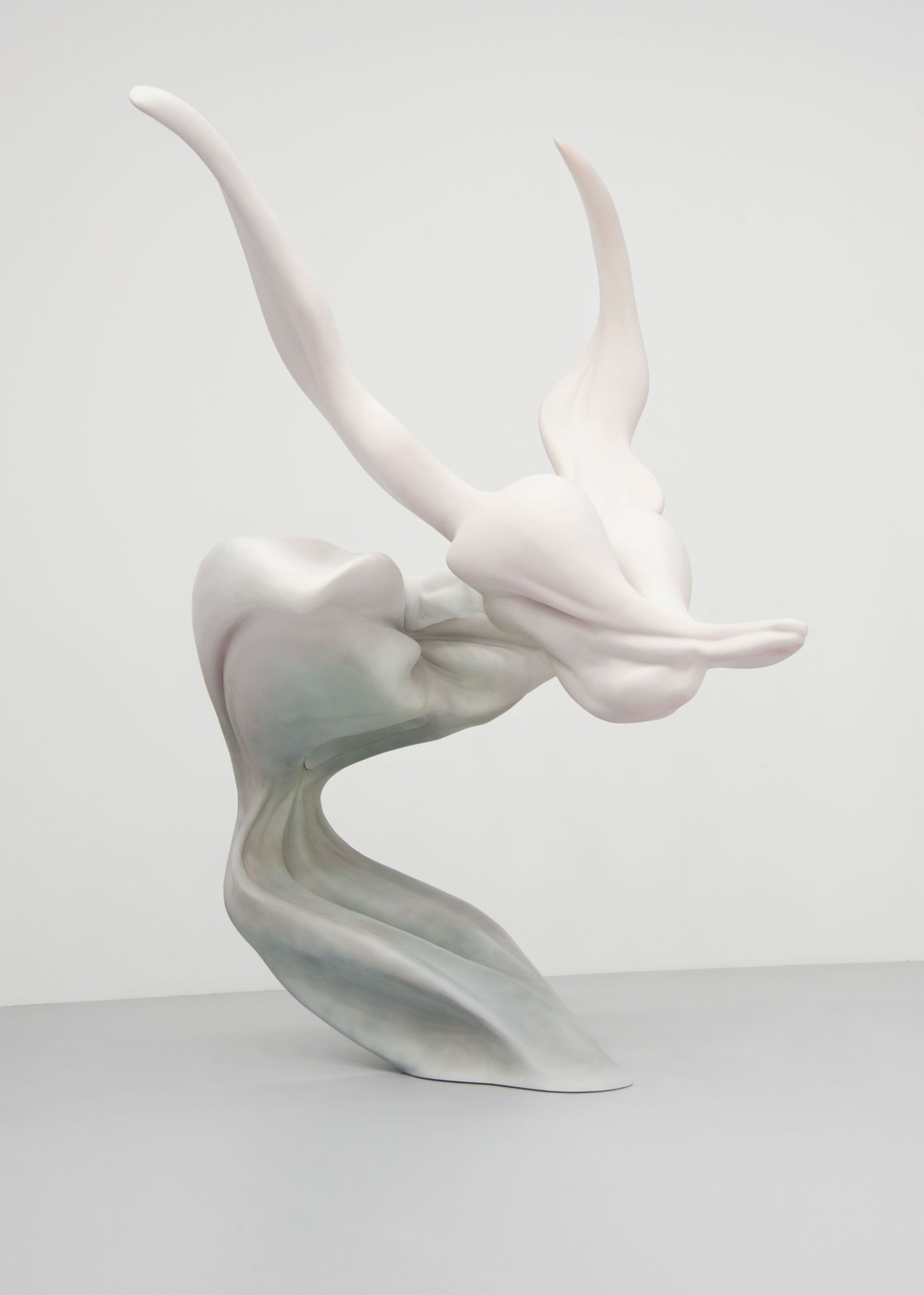
For the second edition of RIBOCA, you’re bringing an existing work, right?
Yes. They’re projects I’ve been working on over the past year, which are called Mist and High Tide. They’re about how climate change might trigger the birth of spirituality in animals. As you see here, this is a marine mammal that’s dying, floating upside down. It looks like it’s emerging from under the water. It’s in the process of dying, its skin is assuming an unhealthy colour. It’s in a slow process of transformation. It’s almost as if its fins are looking up. When I was designing the sculpture, I was thinking of images of crucifixions. The positioning of the fins makes it look like the animal is trying to reach some sort of transcendence in the face of death. Fins wide open, just floating there, all pale... And then there’s this voice that’s coming from its body and travelling through space. The sculpture will be juxtaposed against a very dark space, because I want to create a feeling of emptiness, within which its soul is connecting to some larger whole. So, it will be travelling through this very large landscape. As if it were a ghost.
But, as far as I understand, it’s also connected to the question of whether, through witnessing the extinction of their peers in the current predicament we’re in, animals might develop spirituality.
Right.
Marguerite Humeau. Mist, exhibition view. The Dead (A drifting, dying marine mammal), 2019
Polystyrene, polyurethane resin, fiberglass, steel skeleton, air pump, electronics, latex, CO / 110 x 550 x 497 cm / Image courtesy of the artist and Clearing New York, Brussels. Photos by Eden Krsmanovic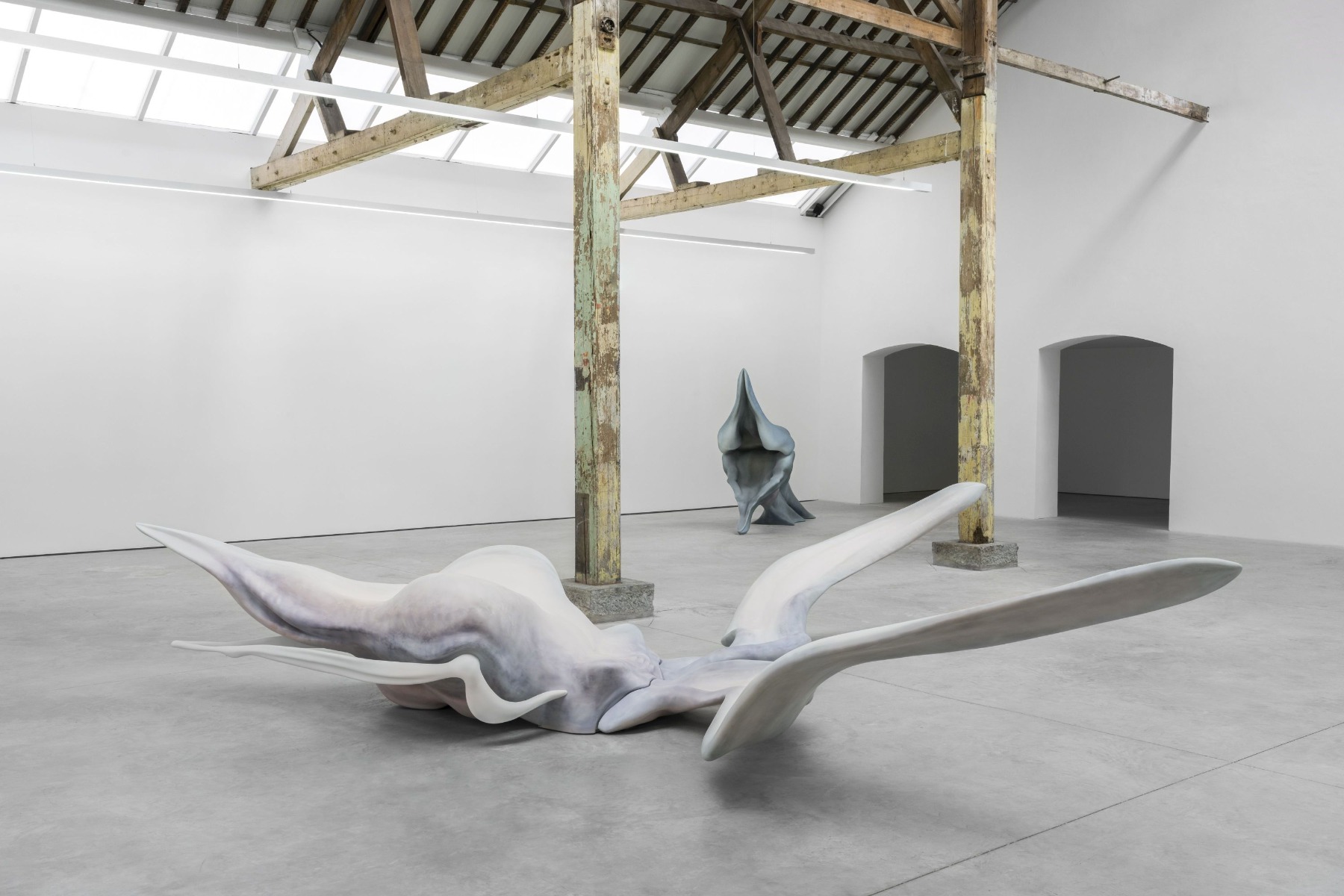
Marguerite Humeau. Mist, exhibition view. The Prayer (A marine mammal invoking higher spirits), 2019.
Polystyrene, polyurethane resin, fiberglass, steel skeleton /
204 x 295 x 100 cm / Image courtesy of the artist and Clearing New York, Brussels. Photos by Eden Krsmanovic
When you think and talk about this, do you use specific definitions for what spirituality is, for what ritual or culture are?
Yes, sure. But specific definitions are problematic, especially when it comes to “spirituality”. It’s such a broad term that it’s really very hard to define. It’s already hard to define for humans, so how might we define it for animals?! I don’t even know how to look for it, because we have no idea what it might look like. But for human spirituality, there were different definitions included, such as the development of superstitious behaviour, a feeling of unity, a feeling of transcendence of space and time, a sense of sacredness... Regarding rituals, however, a very basic definition is “an action that is performed together by a group of beings and that seems meant to be performed in a very particular manner”, as in, there seem to have to be very specific conditions for it to happen. But, I guess, if I saw a group of animals doing something together exactly at the same time, and repeatedly, I would think that maybe it was a ritual.
Marguerite Humeau. Mist, exhibition view. The Dead, The Dancers, and The Air (A shoal of fish performing a breathing ritual in an attempt to bring their dead back to life), 2019. /
8 resin models of fishes breathing systems, 1 resin model of a dead fish breathing system, latex, silicone, CO, acrylic, air pumps, electronics, control system, wood, brushed aluminum
/ 80 x 80.6 x 180.5 /
/ Image courtesy of the artist and Clearing New York, Brussels. Photos by Eden Krsmanovic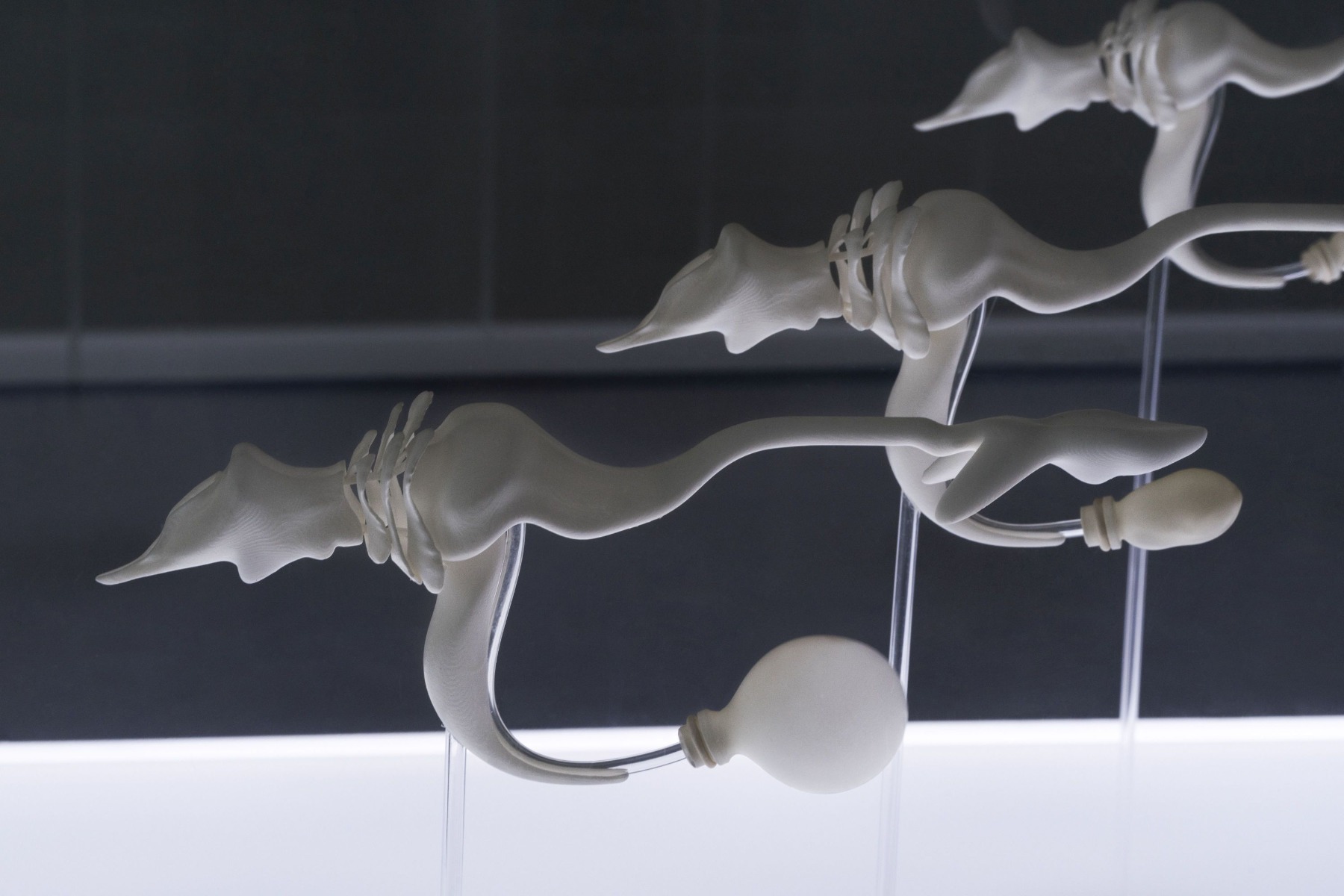
Besides chimpanzees, what are some other striking examples or stories in the animal kingdom that you’ve come across?
There was a paper published a couple of years ago on dolphin suicide. For whales, dolphins and other sea mammals, breathing is an intentional activity; they have to regularly come to the surface of the water for the exchange of oxygen. We, on the other hand, don’t even think about breathing. For them, though, it’s a decision. And it has been witnessed a few times that dolphins just don’t return to the surface anymore – apparently of their own will. This is thought to be a form of suicide. So, that’s an interesting example, although perhaps not so much connected to spirituality as to the consciousness of one’s own death.
What else? Of course, there are the well-known elephant burial rituals that I explored in FOXP2, the project I did with Rebecca [Lamarche-Vadel – Ed.]. It has also been witnessed that groups of elephants wave branches at the full moon and go to very specific rivers to do something like bathing ceremonies. What else? There are many species who have been observed just sitting and watching sunrises and sunsets, especially among the monkeys. Maybe they’re starting to be conscious of the order in nature, of things coming and going in regular cycles? Maybe they discovered it long ago, and we just don’t know about it? We’re just discovering things about them now, but maybe they’ve known such particular things for millions of years.
The theme of this year’s RIBOCA revolves around “re-enchantment”. What are your associations with that?
For me, it’s about what kind of energies or what kind of new mythologies, stories and dreams, what kind of new systems of knowledge and new evolutions could or will emerge because of the shifts and crises we’re experiencing. And so, for me, this connects really well with what I had in mind with this project, specifically because I was always... I started working on it before I was invited to the biennial. I’ve had it on a parallel track in my mind. This hypothesis of a link between climate change and animal spirituality fascinates me, but, of course, I’m not sure about it. But I like the idea that within this crisis, and a terrible one at that, there’s potential for triggering positive changes. Of course, that’s if we see spirituality as a positive change – and I don’t know about that. It’s unsettling. In any case, it might trigger this kind of mutation. To me, that’s how it connects to the biennial.
How did this admittedly peculiar hypothesis occur to you in the first place?
It was rather simple. I was reading this book by Joseph Campbell, in which he says that, in his view, the beginning of humankind was the realisation of our own death, and the first instinct, the first impulse that came from this realisation was the attempt to transcend it – both on the individual level and as a species. At the same time, I was thinking about all these devastating images of animals dying on a massive scale and going extinct, and I thought, as they’re experiencing death on such a scale, maybe this is also what’s happening with them. I was basically applying Joseph Campbell in a very literal way – what would happen if this principle of realisation also applied to the animal kingdom.